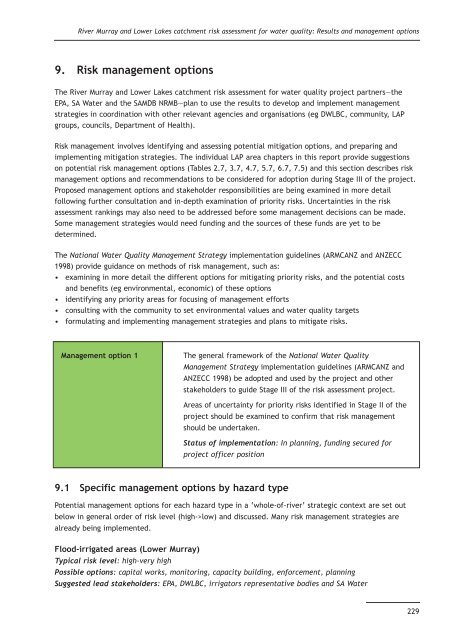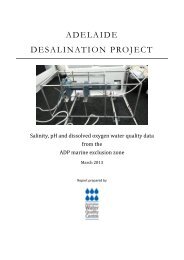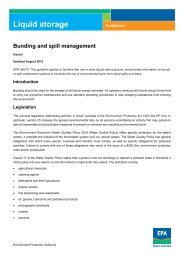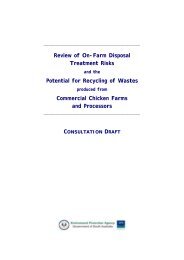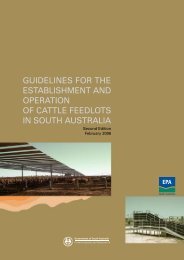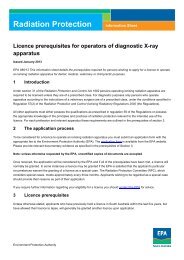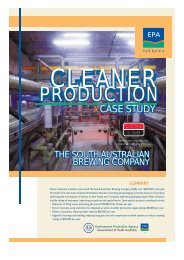2 Renmark to border LAP area assessment - EPA - Sa.gov.au
2 Renmark to border LAP area assessment - EPA - Sa.gov.au
2 Renmark to border LAP area assessment - EPA - Sa.gov.au
Create successful ePaper yourself
Turn your PDF publications into a flip-book with our unique Google optimized e-Paper software.
River Murray and Lower Lakes catchment risk <strong>assessment</strong> for water quality: Results and management options<br />
9. Risk management options<br />
The River Murray and Lower Lakes catchment risk <strong>assessment</strong> for water quality project partners—the<br />
<strong>EPA</strong>, SA Water and the SAMDB NRMB—plan <strong>to</strong> use the results <strong>to</strong> develop and implement management<br />
strategies in coordination with other relevant agencies and organisations (eg DWLBC, community, <strong>LAP</strong><br />
groups, councils, Department of Health).<br />
Risk management involves identifying and assessing potential mitigation options, and preparing and<br />
implementing mitigation strategies. The individual <strong>LAP</strong> <strong>area</strong> chapters in this report provide suggestions<br />
on potential risk management options (Tables 2.7, 3.7, 4.7, 5.7, 6.7, 7.5) and this section describes risk<br />
management options and recommendations <strong>to</strong> be considered for adoption during Stage III of the project.<br />
Proposed management options and stakeholder responsibilities are being examined in more detail<br />
following further consultation and in-depth examination of priority risks. Uncertainties in the risk<br />
<strong>assessment</strong> rankings may also need <strong>to</strong> be addressed before some management decisions can be made.<br />
Some management strategies would need funding and the sources of these funds are yet <strong>to</strong> be<br />
determined.<br />
The National Water Quality Management Strategy implementation guidelines (ARMCANZ and ANZECC<br />
1998) provide guidance on methods of risk management, such as:<br />
• examining in more detail the different options for mitigating priority risks, and the potential costs<br />
and benefits (eg environmental, economic) of these options<br />
• identifying any priority <strong>area</strong>s for focusing of management efforts<br />
• consulting with the community <strong>to</strong> set environmental values and water quality targets<br />
• formulating and implementing management strategies and plans <strong>to</strong> mitigate risks.<br />
Management option 1 The general framework of the National Water Quality<br />
Management Strategy implementation guidelines (ARMCANZ and<br />
ANZECC 1998) be adopted and used by the project and other<br />
stakeholders <strong>to</strong> guide Stage III of the risk <strong>assessment</strong> project.<br />
Areas of uncertainty for priority risks identified in Stage II of the<br />
project should be examined <strong>to</strong> confirm that risk management<br />
should be undertaken.<br />
Status of implementation: In planning, funding secured for<br />
project officer position<br />
9.1 Specific management options by hazard type<br />
Potential management options for each hazard type in a ‘whole-of-river’ strategic context are set out<br />
below in general order of risk level (high->low) and discussed. Many risk management strategies are<br />
already being implemented.<br />
Flood-irrigated <strong>area</strong>s (Lower Murray)<br />
Typical risk level: high–very high<br />
Possible options: capital works, moni<strong>to</strong>ring, capacity building, enforcement, planning<br />
Suggested lead stakeholders: <strong>EPA</strong>, DWLBC, irriga<strong>to</strong>rs representative bodies and SA Water<br />
229


